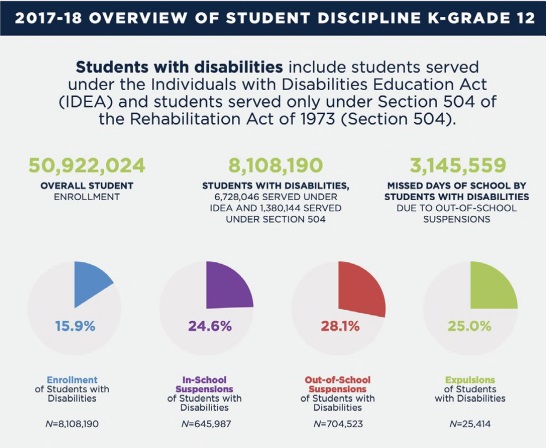WHAT'S HAPPENING
DEPARTMENT OF EDUCATION CALLS ON SCHOOLS TO LIMIT SUSPENSIONS OF STUDENTS WITH DISABILITIES

BY VALERIE C. WILLIAMS
Over seven million children with disabilities and their families rely on the effective, high-quality implementation of the Individuals with Disabilities Education Act (IDEA) to support a lifetime of success.
Make no mistake about it, IDEA — and the rights and protections it affords — impacts a child's future, how they view themselves as learners today and leaders tomorrow. In fact, the National Center for Educational Outcomes (nceo.info/Resources/publications/OnlinePubs/report413/default.html) estimates that 85–90% of children with disabilities can be expected to achieve at grade level when they are provided with the best instruction, supports, and accommodations. Indeed, the promise of IDEA rests with the full implementation of the law.
High-quality implementation of IDEA starts with a clear understanding of the law's requirements, and that is why OSEP recently released the most comprehensive guidance package (sites.ed.gov/idea/new-guidance-helps-schools-support-students-with-disabilities-and- avoid-discriminatory-use-of-discipline) on IDEA's discipline and behavior requirements since the law was reauthorized in 2004.
As our country's first African American OSEP Director, and as the parent of a child with a disability, this guidance holds special meaning to me. It gives hope to parents, strategies to educators, and direction to state and local leadership.
Perhaps, most importantly, it motivates us at the federal, state, district, school, and program levels to have conversations about current disciplinary practices, their immediate and long-term impact on children with disabilities, and how we can change our systems and practices to focus on preventing interfering behaviors rather than relying on punitive, exclusionary approaches. Bottom line: this guidance package compels us to take a smarter approach to addressing discipline in our schools.
The data trends are longstanding and clear: children with disabilities, particularly children of color with disabilities, are disciplined at far greater rates than their peers without disabilities and these trends start as early as preschool and extend throughout high school. For example:
- Preschool students served under IDEA accounted for 22.7 percent of total preschool enrollment but 56.9 percent of preschool students who were expelled.
- School-age students with disabilities served under IDEA represented 13.2 percent of total student enrollment but received 20.5 percent of one or more in-school suspensions and 24.5 percent of one or more out-of-school suspensions.
- During the 2019–20 school year, Black children with disabilities made up 17.2 percent of children with disabilities aged 3–21 served under IDEA yet 43.5 percent of all children with disabil-
